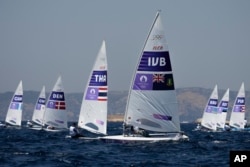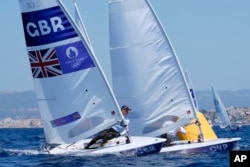The biggest and most diverse fleet of the 2024 Olympics’ sailing events, the one-person dinghy, is scheduled to hit the water Thursday in sweltering Marseille.
The small, white-sailed boats — formerly known as lasers, now called ILCA 6 for women and ILCA 7 for men — go slower, sail deeper into the water and have a less spectacular design than many other vessels in the Olympic marina.
But to the sailors who race them, they are the purest form of the sport.
“It’s very pure, and it’s very close — you’ve got to work for every inch,” said Matt Wearn, 28, of Australia. “You’re not looking to win by a mile, you’re looking to win by a meter.”
Wearn is seeking to defend the gold he won in the event in the Tokyo Games — and so is Anne-Marie Rindom of Denmark, 33, who in addition to a gold from Tokyo has a bronze from Rio de Janeiro and first competed in the London Games in 2012.
“It’s all about the sailor in the boat,” said Rindom, whose parents first took her sailing when she was 2 weeks old. She competed in her first regatta at age 9.
In this class, boats are provided to Olympians only about a week before the Games, leveling the playing field. That makes consistently nailing the smallest tactical detail — an inch of advantage at the starting line, catching a sudden wave to surf ahead, balancing for the additional weight of branding stickers on the sail — the key to winning a medal.
“All these little accuracies make a huge difference,” said Micky Beckett, 29, of Britain. “Being on top of your mental game is absolutely everything.”
That’s also because the boats are so versatile and “basically unsinkable,” in Beckett’s words, that they can — and do — sail in any kind of weather, for hourlong regattas.
Not that the need for physical strength is negligible. In big swells, with spray coming straight at the athletes’ bodies, races can be “quite battering, like being thrown into a washing machine and spat out the other side,” Wearn said. So far in Marseille, the challenge has been the opposite: very low winds under a scorching sun, which can also be draining.
The boats are relatively inexpensive to buy and transport, designed to fit the top of a car. So, they’re the star of World Sailing’s development program, which aims to support athletes from nations without long histories in Olympic sailing, from El Salvador to Fiji to Mozambique.
“It’s cool to see it’s not always the same five nations,” said Nethra Kumanan, 26, of India, who qualified for the Games in the ILCA 6 at the so-called last-chance regatta. “We hope we can give them a fight.”
And a fight it is, because the event features almost twice as many boats as the other sailing categories — more than 80.
“It’s the hardest to win, it’s very equal,” said Tom Saunders, 32, of New Zealand, whose brother also was an Olympic sailor but in the two-person boats.
“It feels like it’s not over till the very end,” echoed Maud Jayet, 28, of Switzerland, who learned sailing on Alpine lakes and competed in the Tokyo Games.
Like her and most sailors in this category, Marit Bouwmeester, 36, of the Netherlands, enjoys shouldering all the responsibility for racing strategy, unlike in two-person boats.
Her tactics have been paying off — she’s won medals in the last three Olympics, snagging silver in London, gold in Rio and bronze in Tokyo. In Marseille, however, she’s trying something new — competing as the mother of a 2-year-old daughter.
“It’s a challenge to do motherhood and top sports,” Bouwmeester said, especially to find the time to train hard and then recover, but there’s also a mental advantage. “If I have a bad day, I can go back to being a mother.”
Pavlos Kontides, 34 and the first athlete from Cyprus to win a medal — for the then-laser in 2012 — is coming back for his fifth Olympics. He also has a toddler in tow who changed his perspective about the relative importance of medals. Not that he doesn’t want one.
“The fire is burning,” he said. “When you’re on a boat, you’re in a different world. You have your own reality on the sea.”
Independence, simplicity, accessibility — for many athletes, that’s what Olympic dinghies represent.
Having started sailing by his village in West Wales when he was 5, Britain’s Beckett says he’s still grateful for his parents’ sacrifices driving all around the U.K. and camping out to bring him to regattas. He hopes the Olympic spotlight can interest more children in taking up this streamlined version of the sport.
“[Sailing] is not as confusing or expensive as it looks,” he said. “You don’t have to be genetically anything — sailing has a home for anybody.”




